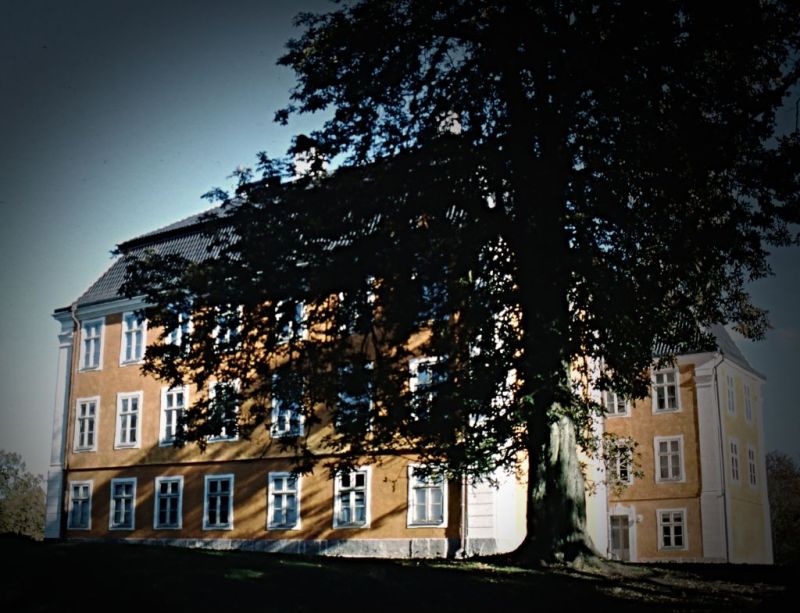ikfoundation.org
The IK Foundation
Promoting Natural & Cultural History
Since 1988


 Crowdfunding Campaign
Crowdfunding Campaignkeep knowledge open, connected, and growing on this textile history resource...
A LINEN CUPBOARD
– in a Manor House 1766
A rediscovered four-page handwritten document dated 1766 reveals many details about linen kept in a manor house this year. The inventory was set up after the housekeeper Madam Nordenmarck’s death at Christinehof in southernmost Sweden, one of the aristocratic Piper family’s properties. Besides recording every item, this list gives glimpses into the preference for luxury textiles domestically produced and imported from Pomeranian and Dutch manufacturers. This included material culture in a wealthy household, when and from where linen had been moved from one of their other properties over the recent years, and the marking of linen. This essay will present the complete transcription in a translation from Swedish for the very first time – assisted by a contemporary map, a traveller-cum-surveyor’s observations, a preserved linen damask napkin and a silhouette cutout of the then tenant in tail Carl Fredrik Piper.
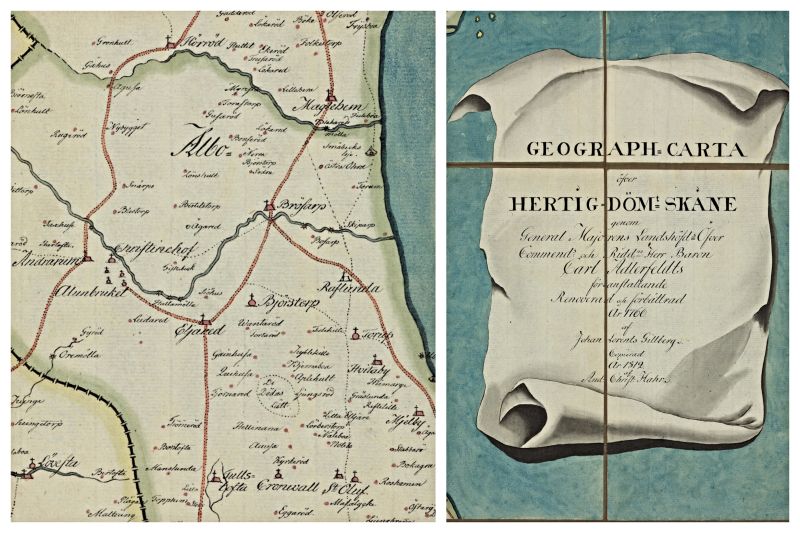 This map section of the eastern district of Skåne province is an interesting contemporary source with the inventory. It registered linen storage of the aristocratic family in one of their manor houses in 1766. The property ‘Christinehof’ was marked in an enlarged font on the map, slightly below the district name ‘Albo’. (Courtesy: Uppsala University Library, Sweden. Alvin-record:98362. Part of map. Public Domain).
This map section of the eastern district of Skåne province is an interesting contemporary source with the inventory. It registered linen storage of the aristocratic family in one of their manor houses in 1766. The property ‘Christinehof’ was marked in an enlarged font on the map, slightly below the district name ‘Albo’. (Courtesy: Uppsala University Library, Sweden. Alvin-record:98362. Part of map. Public Domain).This particular map had been improved by the surveyor Johan Lorens Gillberg, a man who also made an in-depth description (1767) of the manor house and the adjoining ‘Alunbruket’ [alum works] – both in the ownership of the Piper family estate in the tail. The size and importance of the manor house and early alum quarry seem to have impressed the visitor, who, among many matters, stated: ‘In 1737 Christina Piper arranged to build a large Corps de Logis with two wings, a three-story house… Surrounding the Corps de Logis and the wings, the garden is situated on two levels, divided into quarters by hedges, parterres and fruit trees, everything inside a high stone wall’. On the inside of this garden wall, the wealthy family and their guests had meals on linen damask diaper tablecloths and slept between Holland linen sheets. Simultaneously, the very closely situated alum works at this time employed many individuals who lived their everyday lives under entirely different circumstances. According to Gillberg’s neutral description, the industrial community included the alum quarries, magazines, family houses, shops, a school for poor children and ‘alum workers, around 300 together with loggers, blacksmiths, tailors, shoemakers and several other necessary craftsmen.’
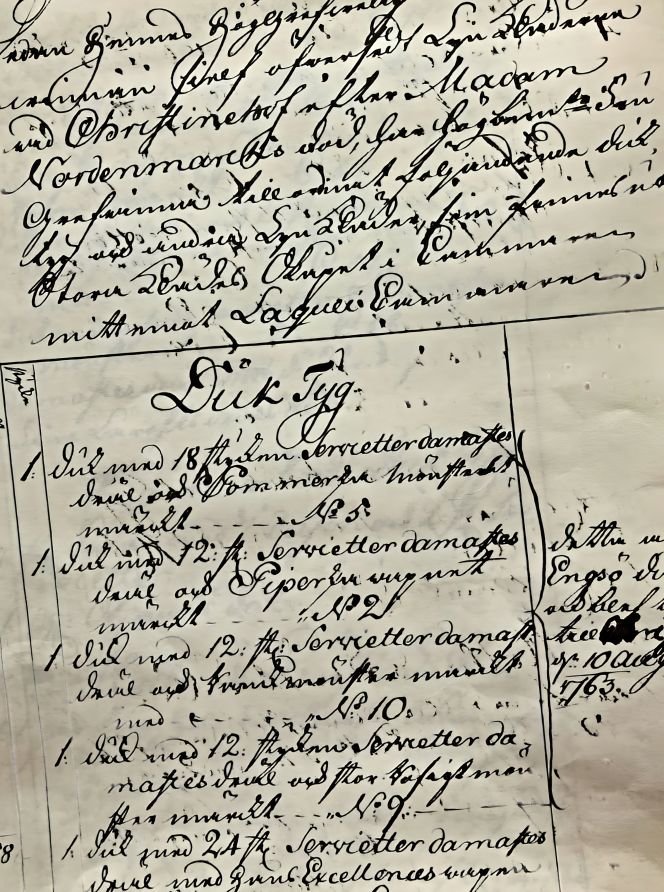 Listed linen at Christinehof Manor House in 1766. (Collection: Historical Archive of Högestad and Christinehof, Piper Family Archive. D/1a). Photo: Viveka Hansen, The IK Foundation.
Listed linen at Christinehof Manor House in 1766. (Collection: Historical Archive of Högestad and Christinehof, Piper Family Archive. D/1a). Photo: Viveka Hansen, The IK Foundation.The introduction of the 1766 inventory illustrated above informed that: ’Since herewith the Honourable Countess of the higher nobility has overlooked the Linen at Christinehof after Madam Nordenmark’s death, the Honourable Countess has arranged for the following tablecloths and other linen, which are kept in the large textile cupboard in the Chamber just opposite the Footmen’s Chamber.’ Furthermore, the same linen cupboard was listed in an inventory of all household objects at Christinehof Manor house dated 1758, of which linen was ‘left in the care of Madam Nordenmarck’. No more information, however, has been traced to the housekeeper, who had at least worked for eight years at the manor house. Since this year, some items had been added from the Ängsö manor house, whilst other linens were not longer part of the linen storage in 1766, either due to wear and tear, lost/stolen or transported to one of the other family estates without notification about the matter. Please see below for the complete transcription in an English translation of the detailed document dated 1766, with additional contemporary notes in italics within square brackets.
Tablecloths
- 1 Tablecloth with 18 Damask Diaper Napkins and the Pomeranian pattern, marked No. 5.
- 1 Tablecloth with 12 Damask Diaper Napkins and the Piper Family coats of arms, marked No. 2.
- 1 Tablecloth with 12 Damask Diaper Napkins and [kanik] pattern, marked with No. 10.
- 1 Tablecloth with 12 Damask Diaper Napkins and large rose patterns, marked No. 9. | These [four posts] came from Ängsö manor house to Christinehof on 10 August in 1763]
- 1 Tablecloth with 24 Damask Diaper Napkins with His Excellence coats of arms, marked C. [1758]
- 3 Tablecloths with 18 Damask Diaper Napkins, marked with C. [1758]
- 2 Tablecloths with 3 dozen Napkins, 10 Napkins marked with C 57. [1757]
- 2 Tablecloths with 1 dozen and 9 pieces of Napkins, marked C 54.
- 2 Tablecloths with 1 dozen and 11 pieces of Diaper woven Napkins marked C.C.F.P.
- 2 Tablecloths, 3 dozen Napkins with night and day pattern, marked C 57.
- 4 Tablecloths, 6 dozen Napkins with French rose pattern, marked C 57.
- Tablecloths, 5 dozen and 11 pieces of Napkins, with the Fortification pattern, marked C 57.
- 2 Tablecloths, 3 dozen Napkins with Pomeranian pattern, marked C 58. [1758]
- 3 Damask Diaper Tea tablecloths.
- 5 Fine Linen Diapers ditto.
Chamber Table Linen Tablecloths
- 7 Tablecloths with 7 dozen and 2 pieces of Napkins.
- 1 Tablecloth for the sideboard.
Holland Linen Sheets
- 1 pair of fine Holland linen sheets of 2 1/2 widths, marked C 57 with 2 pairs of pillowcases.
- 1 pair of ditto of 2 widths with 1 pair of pillowcases, marked C 57.
- 1 pair fine ditto, purchased in Ystad of 2 widths with 2 pairs of pillowcases, marked with C 57.
- 1 pair of ditto of the same sort of 3 widths with 1 pair of large and pair of small pillowcases, marked C 57.
- 1 pair of old linen sheets for the High Nobility Count’ and Countess’ own bed, marked S.C.P, with 6 pillowcases marked with No. 12 & of which 4 with C. 1757 & whilst 3 have no marking other than No. 3, 5 & 6.
Additions in 1754
- 1 pair of Linen sheets of 3 widths with 1 pair of pillowcases, marked C 54.
- 1 pair ditto of 2 widths and 1 pair of ditto, marked C 54.
- 1 pair ditto of 2 widths and 1 pair of ditto, marked C 54.
- 1 pair ditto of 2 1/2 widths and 1 pair of ditto, marked C 54.
- 1 pair ditto of 2 widths and 1 pair of ditto, marked C 54.
- 1 pair ditto of 2 widths and 1 pair of ditto, marked C 54.
- 1 pair ditto of 2 widths and 1 pair of ditto, marked C 54.
- 1 pair ditto of 3 widths and 1 pair of ditto, marked C 54.
- 1 pair ditto of 3 widths and 1 pair of ditto, marked C 54.
- 1 pair ditto of 3 widths and 1 pair of ditto, marked C 54.
- 1 pair ditto of 2 1/2 widths marked C 57, with 1 pair of pillowcases marked with C 54.
- 1 par ditto of 2 widths C 57, with 1 pair of pillowcases C 54.
Additions in 1757
- 1 pair ditto of 2 widths and 1 pair of pillowcases, marked C 57.
- 1 pair ditto of 2 widths and 1 pair of ditto, marked C 57.
- 1 pair ditto of 2 widths and 1 pair of ditto, marked C 57.
- 1 pair ditto of 2 widths, without pillowcases, marked C 57.
Additions in 1758
- 1 pair ditto of 3 widths with 2 pairs of pillowcases, marked C 58.
- 1 pair ditto of 2 1/2 widths with 2 pairs of pillowcases, marked C 58.
- 1 pair ditto of 3 widths with 3 pairs of pillowcases, marked C 58. [The addition in the year 1760]
Linen Tow Sheets
Additions in 1754
- 3 pairs of Linen Tow sheets, marked C 54.
Additions in 1757
- 3 pairs ditto, marked with C 57.
Additions in 1758
- 2 pairs ditto, marked with C 58. [These came from Krageholm manor house]
- 1 pair ditto, with C.P.1. [These came from Krageholm manor house]
- 3 pairs ditto, marked with C 58.
Additions in 1759
- 2 pairs ditto, marked with C 59.
For the Stable
- 2 pairs of 3/1 Twill sheets, marked C.S.57.
Christinehof: 6 July in 1766’
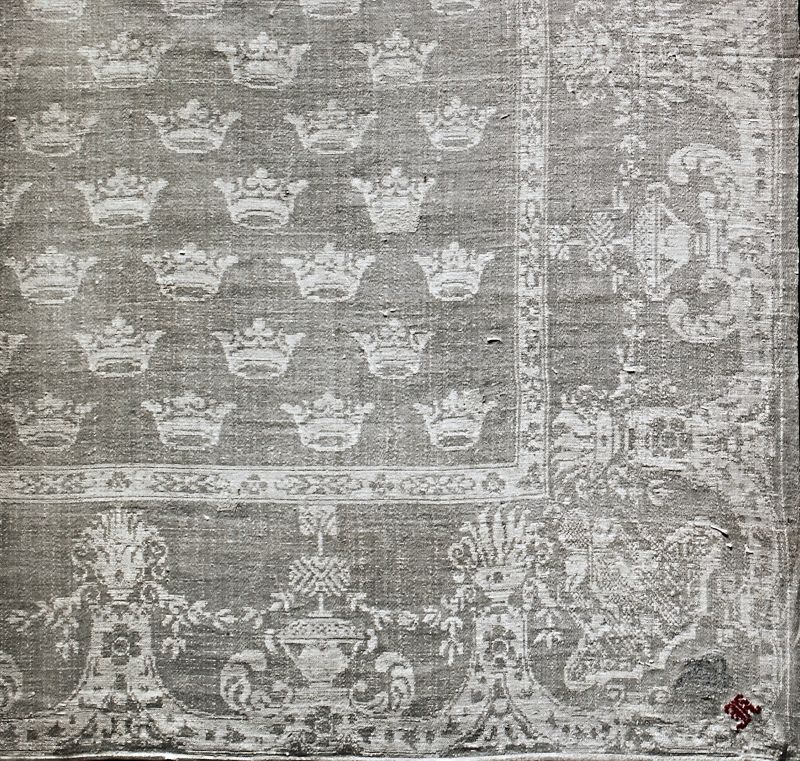 None of the listed linens in the 1766 document has been possible to trace; some may be preserved in private collections, but if so, it is unknown where. However, this damask linen napkin, woven at the Flor Linen Manufacturer during the second half of the 18th century, is an interesting comparison. Even if this particular napkin once was part of the Royal household, due to the interwoven blue crown, still visible even if faded today, the Piper family was a frequent customer at this Swedish linen manufacturer. A matter described in earlier essays, see sources, researched via inventories, correspondence, shares, etc., kept within the Piper Family Archive. (Courtesy: The Nordic Museum, Stockholm, Sweden. NM.0240780. DigitaltMuseum).
None of the listed linens in the 1766 document has been possible to trace; some may be preserved in private collections, but if so, it is unknown where. However, this damask linen napkin, woven at the Flor Linen Manufacturer during the second half of the 18th century, is an interesting comparison. Even if this particular napkin once was part of the Royal household, due to the interwoven blue crown, still visible even if faded today, the Piper family was a frequent customer at this Swedish linen manufacturer. A matter described in earlier essays, see sources, researched via inventories, correspondence, shares, etc., kept within the Piper Family Archive. (Courtesy: The Nordic Museum, Stockholm, Sweden. NM.0240780. DigitaltMuseum).The repeated mention of ‘2 widths’, ‘2 1/2 widths’ and ‘3 widths’ in the document referred to how many pieces of linen cloths were neatly stitched together to achieve the required sheet width depending on the bed size. This was due to the narrow loom width in the mid-18th century, which made it impossible to weave full-width sheets and tablecloths alike. For some unknown reason, however, the widths were not mentioned for the tablecloths listed in the transcribed list above.
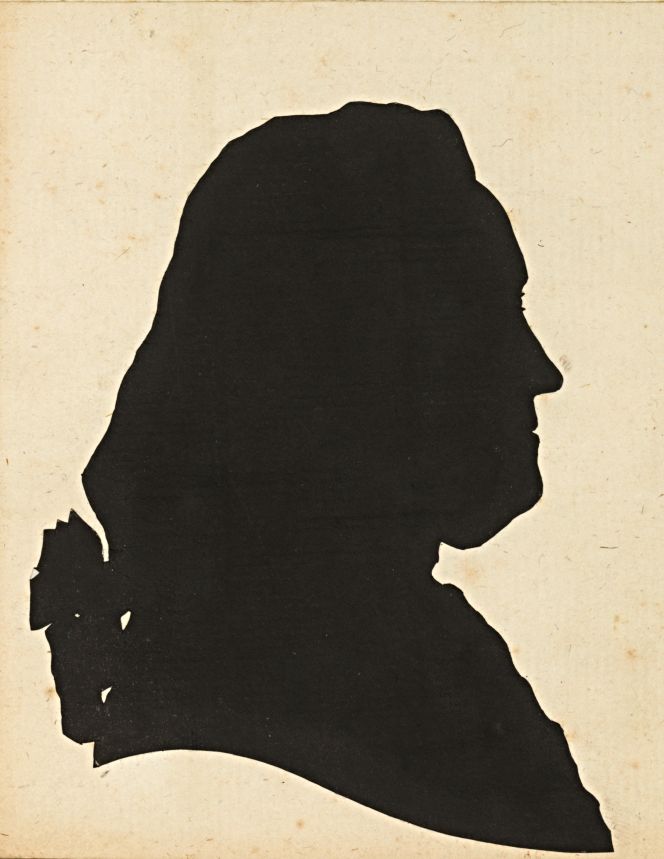 A silhouette cutout depicting Carl Fredrik Piper (1700-1770) in middle age during the 1750s or 1760s. That is to say, it was contemporary with the linen inventory in 1766 when he was the tenant in the tail of the Piper family. The Christinehof manor house was one of at least ten large-sized properties together with the alum works included in this family estate of the tail, founded by his mother, Christina Piper (1673-1752) in 1747. (Courtesy: Uppsala University Library Sweden. Alvin-record: 148582. Public Domain).
A silhouette cutout depicting Carl Fredrik Piper (1700-1770) in middle age during the 1750s or 1760s. That is to say, it was contemporary with the linen inventory in 1766 when he was the tenant in the tail of the Piper family. The Christinehof manor house was one of at least ten large-sized properties together with the alum works included in this family estate of the tail, founded by his mother, Christina Piper (1673-1752) in 1747. (Courtesy: Uppsala University Library Sweden. Alvin-record: 148582. Public Domain).Interestingly, from this list, it has also been possible to reveal that some of the finest linen sheets had been acquired locally in the port town of Ystad, which is situated on the southern coast of Sweden, at a convenient distance of 35 kilometres by horse-drawn carriage from Christinehof Manor house. The fine linen was initially imported from Holland, transported over land through the German lands to Stralsund and from there by ship over the Baltic Sea to Ystad: Listed as: ’1 pair of fine Holland linen sheets, purchased in Ystad of 2 widths with 2 pairs of pillowcases, marked with C 57.’ The harbour town Stralsund, situated in Pomerania, can also enlighten the origin and the availability of some of these listed household textiles: ‘1 Tablecloth with 18 Damask Diaper Napkins’ and ‘2 Tablecloths and 3 dozen Napkins’ all with a Pomeranian pattern. Furthermore, Stralsund was part of Swedish Pomerania (from 1630 to 1815) as a dominion of Sweden during this period. A reality that even more emphasises the close link of the Swedish nobility in southernmost Sweden via this harbour, opening up ample opportunities to import desired goods from the Continent.
Sources:
- Fischer, Ernst, Linvävarämbetet i Malmö och det skånska linneväveriet, Malmö 1959.
- Geijer, Agnes, Ur textilkonstens historia, Stockholm 1994 (pp. 205-210).
- Gillberg, Joh. Lor., Beskrivning över Christianstads Län uti Hertigdömet Skåne, Lund 1767 (Facsimile, Lund 1980. Quotes in translation from Swedish: pp. 94 & 97).
- Hansen, Viveka, Inventariüm uppå meübler och allehanda hüüsgeråd vid Christinehofs Herregård upprättade åhr 1758, Piperska Handlingar No. 2, London & Whitby 2004 (pp. 54-55, transcription of listed linen in 1758).
- Hansen, Viveka, Katalog över Högestads & Christinehofs Fideikommiss, Historiska Arkiv, Piperska Handlingar No. 3, London & Christinehof 2016.
- Hansen, Viveka, TEXTILIS Essays: ‘Mattresses, Bolsters and Bedlinen – at a Manor House in 1758’ (No: CXIX | June 10, 2020) & ‘Linen Tablecloths and Napkins – at a Manor House in 1758’ (No: CXXI |August 10, 2020).
- Historical Archive of Högestad and Christinehof, Sweden (Piper Family Archive. D/1a: Inventory in 1766 & Inventory in 1758).
More in Books & Art:
Essays
The iTEXTILIS is a division of The IK Workshop Society – a global and unique forum for all those interested in Natural & Cultural History.
Open Access Essays by Textile Historian Viveka Hansen
Textile historian Viveka Hansen offers a collection of open-access essays, published under Creative Commons licenses and freely available to all. These essays weave together her latest research, previously published monographs, and earlier projects dating back to the late 1980s. Some essays include rare archival material — originally published in other languages — now translated into English for the first time. These texts reveal little-known aspects of textile history, previously accessible mainly to audiences in Northern Europe. Hansen’s work spans a rich range of topics: the global textile trade, material culture, cloth manufacturing, fashion history, natural dyeing techniques, and the fascinating world of early travelling naturalists — notably the “Linnaean network” — all examined through a global historical lens.
Help secure the future of open access at iTEXTILIS essays! Your donation will keep knowledge open, connected, and growing on this textile history resource.
been copied to your clipboard




– a truly European organisation since 1988
Legal issues | Forget me | and much more...
You are welcome to use the information and knowledge from
The IK Workshop Society, as long as you follow a few simple rules.
LEARN MORE & I AGREE


